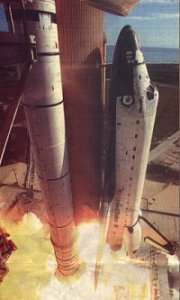
Columbia and The BAe Bail-out
At around 2pm GMT the Space Shuttle Columbia disintegrated while re-entering the Earth’s atmosphere. Tragically, all seven crew members perished. One of them, Colonel Ilan Ramon, was Israel’s first citizen to join the space programme.

Cosmic Conspiracies can reveal that just one day before this second shuttle disaster, Britain’s biggest defence company BAe Systems (formerly known as British Aerospace), gave away its space technology interests to its biggest rival! Did they know something the rest of us didn’t?
"BAE Systems yesterday (31st Jan 2003) ditched its share of loss-making space joint venture Astrium, transferring its remaining 25% stake in the business to rival European Aeronautic Defence and Space for nothing. Controversially, the British defence contractor has also handed its Continental European rival control of Paradigm Secure Communications, a consortium which is close to concluding a £2bn communications contract with the Ministry of Defence. While BAe will continue to produce systems for certain satellites, the deal marks the end of the company's involvement with rockets and satellite platforms." (1)
This turn of events followed problematic financial wrangling over the sale price of Astrium. The rival company Eads who have taken over Astrium have a stake in Arianespace, who make the European Ariane rocket. So the immediate implications are centred within the European sphere of space and defence communications technology.
It should also be noted that during the following week BAe was down-graded further by the credit ratings agency Standard and Poor due to problems connected with their pension fund (2): BAe were already in trouble financially. Nevertheless, as confidence plummets in space tech, BAe's decision seems to have been timely to say the least.
Business Implications
We can be left in no doubt that the Columbia shuttle disaster will place the global aerospace business in further difficulties generally, as this item from the insider publication ‘Lloyd’s List’ demonstrates :
“Underwriters in both marine cargo and on aerospace business will make renewed efforts to force premiums higher, said market sources. With its high-profile loss of life, the disaster has highlighted the dangers in the space industry, which in 2002 suffered a reported $300m loss from a wrongly orbited Proton-powered Astra satellite, and other setbacks from a Soyuz cargo rocket explosion and Ariane 5 losses.
“Underwriters are anxiously awaiting the investigation into the cause of the Columbia crash which could result in product liability exposure. Aviation insurance sources in the US said that Boeing and Lockheed Martin, joint owners of prime shuttle contractor United Space Alliance, and other companies working on the shuttle programme would be covered under the government contractor immunity doctrine. This provides that a contractor is not liable for damages as long as it performs in accordance with government specifications, and providing that it does not identify flaws in those specifications.” (3)
In a brilliant fit of clairvoyance, BAe seem to have recognised the growing potential pitfalls associated with doing business in this sector, and ditched their liabilities before things got even worse.
Because, remarkably, the timing of BAe’s decision to ditch Astrium occurred while Columbia was still in orbit. As we will see, there has been a great deal of speculation that the disaster occurred as a result of damage incurred during the launch on 16th January. Many suspect that NASA knew that the mission might be in trouble. But how could BAe Systems, a British defence contractor not directly associated with the shuttle mission, have known in advance of the shuttle calamity?
Signals Intelligence
The British and Americans have always been very, very close on matters of national security. NSA and GCHQ (the British listening post based in nearby Cheltenham (4)) are practically joined at the hip, bound together through directives established in the 1948 UKUSA agreement, a politically acknowledged pact between the two countries whose details have never been published. There is a second tier to the UKUSA framework, consisting of Canada, New Zealand and Australia, making an extensive and dominant Anglophone National Security and Intelligence network.
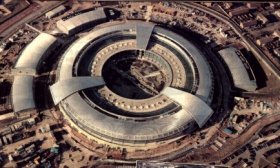
According to government documents declassified in January 2002, a briefing in 1970 to the then British Prime Minister Ted Heath included the following information about the special relationship between the UK and US vis-à-vis the sharing of intelligence:
“Without intelligence of US origin, and particularly without that derived from the NSA/GCHQ Agreement…the (UK) Defence Intelligence Staff would be unable to assess most of the critical aspects of military, economic, scientific and technical developments in the Soviet bloc and China and would be less capable of producing reliable intelligence on the other countries hostile to UK interests. The main reason why the Americans make so much information available to us…is that they may have a meaningful exchange of views on matters of common interest from a basis of common intelligence.” (5)
Thus it's no surprise that the British Government always supports the USA on military or security policy, despite adverse public opinion here in Britain over, say, Iraq. Neither is it a surprise when the rest of the EU and Britain become deeply divided on the same issues, despite our membership of the EU (membership supported more by US interests than by British public opinion: the US wants the UK in the EU to neutralise the French/German power base that lies at the heart of the European Union; what the US administration has recently dubbed the ‘Old Europe’.)
One of the arguments that's been levelled at the ECHELON eavesdropping system used by NSA/GCHQ is that it has been used to give intelligence information to American and British companies about foreign competitors. The EU parliament has been publicly up in arms about this, although for obvious reasons the British and American governments tend to avoid discussing the subject. So we know that Anglo-American business interests have been party to intelligence gleaned by NSA/GCHQ in the past. Quite clearly even top secret ‘Mayday’ transmissions between Columbia and Mission Control could, and would have been intercepted and decrypted by NSA/GCHQ. If the plight of the Columbia shuttle was known to NASA it was also known to the Anglo-American Signals Intelligence gatherers, and by extension the US and UK Governments.
It seems eminently plausible that BAe Systems
were in receipt of intelligence about the dangers faced by the space shuttle
and its crew. Given the on-going wrangling regarding the sale of
BAe’s space technology assets to its competitor Eads, this kind of intelligence
would have been vital to the financial interests of Britain’s largest defence
contractor, particularly as war looms in the Gulf.
The Left Wing
There are widespread suspicions that heat resistant tiles covering Columbia’s left wing were damaged by a piece of foam insulation that broke off the external fuel tank just after launch. Images have been circulating on the Internet showing suspicious marks on the shuttle’s exterior, yet NASA rejects this theory.
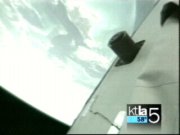
Cosmic Conspiracies understands that Columbia re-entered Earth’s atmosphere at a shallower angle than normal, perhaps indicating that NASA had known about the alleged damage to the shuttle’s wing and were covertly trying to minimise the danger to the manned spacecraft.
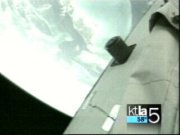
Alas, Columbia’s heat-resistant exterior catastrophically failed. Did NASA know that this re-entry was more dangerous than normal? Was the writing on the wall for the brave shuttle crew? NASA deny this, and have emphatically rejected suggestions that the heat-resistant tiles had been damaged just after launch. But are they simply trying to cover up their own negligence? From a public relations point of view, it would be worse, surely, to admit that they knew that the shuttle was at risk of burning up on re-entry, yet were powerless to do anything about it. Perhaps the only response at Mission Control to the potential dangers was for the staff to shut up and keep their collective fingers crossed…
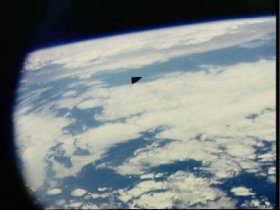
It is a fact that the shuttle’s budget has decreased in real terms by 40% since 1990, putting safety at jeopardy. During a news report after the Columbia disaster I heard one expert commentator note that ‘tile repair kits’ were no longer carried on the shuttle, preventing the astronauts from carrying out an emergency space-walk to mend any damage to the shuttle’s heat shielding.
Yet the aging shuttles would have been more likely to succumb to wear and tear over time, increasing the need for such emergency equipment on board. Perhaps NASA felt that it would appear unseemly to have their astronauts fixing their damaged vehicle on the equivalent of the orbital hard-shoulder?
Maybe they felt this would start to look too much like the Russian Cosmonauts when they were constantly mending Mir.
NASA have ordered a full inquiry into the disaster. We are not confident of its outcome. Given the fact that important evidence pertaining to the TWA 800 disaster in 1996 was blatantly ignored by the authorities (6), it seems equally likely that there will be no official mention about prior knowledge of damage to Columbia. Yet while images of a damaged orbiting shuttle continue to circulate, the suspicion will grow that the public have once again been duped.
Update Feb 2003 : The NASA E-mails
In what appears to be confirmatory evidence that NASA engineers knew about the potential risks Columbia might be subject to upon re-entry, a series of published internal e-mails have further fuelled speculation that there is more to the events surrounding the Columbia disaster than meets the eye. Either NASA are hiding their own inability to manage the impending disaster, or they were simply negligent in responding to warnings issued by engineering staff during the flight.
"Internal e-mails released Wednesday had NASA Administrator Sean O’Keefe on the hot seat when he appeared before the House Science Committee in Washington on Thursday. O’Keefe and other insiders said e-mail discussions among NASA engineers just before the Feb. 1 space shuttle disaster did not suggest that officials knew Columbia had serious problems before it broke apart over Texas. O’Keefe told U.S. Rep. Anthony Weiner that senior engineers made the right decision by not passing their speculations about worst-case scenarios to senior managers." (7)
Space journalist and historian James Oberg has come to NASA's defence, insisting that the 'infamous' e-mails were nothing more than speculation of worst-case scenarios, many based upon potentialities so extreme as to be easily dismissed. Unfortunaterly, in a grim case of reality being stranger than fiction, one of those potentialities came to pass:
"NBC space analyst James Oberg points out that some of the engineers who figure most prominently in the discussion were from MMACS — the "Mechanical, Maintenance, Arm and Crew Systems" group on the flight control team at NASA’s Johnson Space Center.
"They are supposed to predict the way that all plausible failures could appear to them on data on their consoles, and then develop in advance the recommendations they would need to make to the flight director for the crew to follow," Oberg said. "They are not responsible for ‘engineering analysis’ of past events and did not take part in any debate about the seriousness of the tile damage." " (8)
Which begs the question: If the engineers from MMACS are hired to analyse technical problems on the space shuttle flight, and then report them, then should that information not be relayed to the Johnson Space Flight team directing events in orbit? Otherwise, what's the point of having the MMACS team at all? Word must have got through, and should have been taken into account when assessing the damage incurred upon lift-off. It appears that a judgement was made somewhere along the line that the threat to the shuttle was minimal:
"Amid all these discussions, it was up to a different team at Johnson, called the Mission Evaluation Room, or MER, to assess the actual threat to the shuttle. On the basis of computer simulations and past experience, MER had concluded that Columbia would be OK. That’s why David Lechner, head of the MMACS group, wrote to other engineers that "we hope that the debris impact analyses are correct" and that the e-mail discussion would be moot: because the alternatives for dealing with a worst-case tile scenario were so unpalatable." (8)
So maybe NASA were simply incapable of preventing the disaster, given the 'unpalatable' options open to them, and could only stand back and watch helplessly as events unravelled. Either way, the e-mails provide evidence that a potential disaster was being discussed within NASA's engineering circles, and that this may have constituted the kind of Signals Intelligence that might have caused great concern beyond NASA, even if the staff at the Mission Evaluation Room ultimately, and wrongly, dismissed the threat.
This leaves open the possibility that BAe may well have been tipped off by British Intelligence, even if NASA itself ignored the problems raised by the MMACS engineers. And, potentially, the BAe Bail-Out could provide evidence that things were not looking good at Mission Control, despite the indignation that such suggestions are being met with by NASA.
Update April 2003: Eads in Crisis
Barely weeks after the Columbia disaster, and the take-over of BAe Systems' space technology assets, the European aerospace group Eads is in deep financial trouble. According to UFO Magazine (May 2003, p15) the company has warned that it may have to discontinue launching satellites without aid from European governments. The future of the Ariane launch system is under direct threat, according to Francois Auque, head of Eads' space division. Blame is heaped upon the dramatic decline of the telecoms market, affecting the satellite industry to the extent that Arianespace has announced a 30% cut in its workforce. The problem is exacerbated by the cancellation of several projects by the French Space Agency.
However, UFO
Magazine (9) also reports that the company 'Astrium' is planning to
build the satellite system for the proposed 'Earthshine' mission
(May 2003, p17). Funding is likely to be granted by the Particle
Physics and Astronomy Research Council, the Natural Environment Research
Council and the department of Trade and Industry. Given that Astrium
has now been handed over for free to the now struggling Franco-German group
Eads, one wonders what posible future awaits this 'British' space mission.
Written by
Andy
Lloyd, with additional research by Dave and
Martin Cosnette, 13th February 2003, Updated 28th February and 25th April
2003
author of 'The Dark Star'
(2005), 'Ezekiel One'
(2009), 'The Followers of
Horus' (2010) and 'Darker Stars' (2019) Published by Timeless Voyager Press
References
1) Richard Wray "BAE ditches satellite stake" The Guardian p28 1/2/03
2) J. Treanor “Blue chips on ratings watch” The Guardian 8/2/03
3) J. Brewer & J. McLaughlin “Shuttle to hit marine insurers for $17m” Lloyd’s List 4/2/03. (This obscure publication rather bizarrely landed in our PO. Box last week. Lucky that…)
4) The new £1.1bn GCHQ building (‘The Doughnut’) was recently described as ‘looking as if a giant alien space craft had landed in the middle of a suburban housing estate’ by Martin Smith in The Mail on Sunday 26/1/03. It will ‘house one of the world’s most powerful computer systems encased in a bomb-proof underground chamber the size of the Albert Hall’.
5) P. Hennessy “Skills still central to fighting terror” The Citizen 24/10/02 p24, from his book: “The Secret State: Whitehall and the Cold War” Allen Lane
6) In a poll conducted in the US in September 1996 ‘Some 41% of respondents believed the government was covering up the truth about TWA Flight 800’: G. Birdsall “Polling the Pollsters” UFO Magazine Feb 2003 p21
7) Ted Streuli "NASA chief: E-mail actions were correct" The Daily News, Galveston 28th February 2003
http://www.galvestondailynews.com/story.lasso?wcd=8250
8) Alan Boyle’s ‘Cosmic Log’ "Decoding NASA’s e-mail" 27th Feb. 2003
http://www.msnbc.com/news/750150.asp?0dm=T29BT
9) UFO Magazine "EADS pleads for cash" and "UK seeks to go it alone
in space" May 2003 QPIL